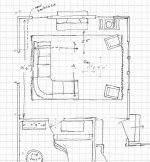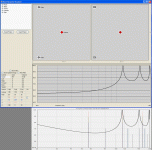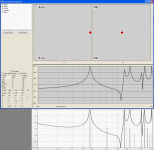I find the curve disappears if I raise the elevation of the speakers. It comes back when I adjust the depth in the room (even if slightly). Otherwise it works very well.
Ability to adjust alpha is a nice touch.
David
Yea, a slight bug that I need to fix, but yes, just click on just about anything and it will come back.
...If that did not work then I am not clear why except that no one else has tried it on an XP machine...
Works for me with WinXP + IE7, and WinVista + IE8. Thanks!
I ran a few comparisons with REW and results are much more similar than they are different.
The main exception, is that REW apparently includes "room gain" and you do not.
In your *.pdf help file it is stated:
"2) There is no “room gain” – there is no “gain” at LFs for real sources, the response always falls as the frequency goes down."
Can you clarify this? It was my understanding that "gain" at LF was a function of the room(size, stiffness, leaks, etc) not the sources.
For example, I have measured LF "gain" in automobiles, but not in my living room with all its doorways.
Oh, one other question:
Does you program consider oblique and tangential modes or just axial modes?
(Perhaps this might account for some of the small differences compared to REW)
Last edited:
That is correct. I don't see a situation where you would ever want the mains to not be symmetrical. Its a very bad idea. Its too much trouble making them separate for something that one should not do.
Sometimes it's not a matter of choice. There's a door on the right corner of my front wall, so I have to move the pair to the left.
Markus
Here is the solution
"On another note, to clear the ClickOnce cache so you can continue testing. Launch a command prompt with Administrator privs and execute: rundll32 dfshim CleanOnlineAppCache"
That worked, thanks.
Works for me with WinXP + IE7, and WinVista + IE8. Thanks!
I ran a few comparisons with REW and results are much more similar than they are different.
The main exception, is that REW apparently includes "room gain" and you do not.
In your *.pdf help file it is stated:
"2) There is no “room gain” – there is no “gain” at LFs for real sources, the response always falls as the frequency goes down."
Can you clarify this? It was my understanding that "gain" at LF was a function of the room(size, stiffness, leaks, etc) not the sources.
For example, I have measured LF "gain" in automobiles, but not in my living room with all its doorways.
Oh, one other question:
Does you program consider oblique and tangential modes or just axial modes?
(Perhaps this might account for some of the small differences compared to REW)
The calculation considers all the room modes.
There is no "room gain" because there isn't any in a real room. A car has a very low mode, a sort of Helmholtz resonance which is a factor in a small car, but even that vanishes in a van. In any room in a home there is no "room gain" so if REW has this then its wrong. But I seriously doubt that he would make that mistake. It's a myth and experts know this.
How one handles the absorption is critical. There are various ways to do this and I don't know how REW does it. Does REW have complex modes? Or are the Eigenfunctions real and the damping is added only via the wavenumber? Is this wavenumber factor singular or is it three dimensional. All of these will have effects.
I did my PhD on room modeling at LFs so I feel pretty confident that what I am doing is correct within the limitations of the assumptions being made.
One thing that you will note is how hyper-sensitive these calculates are. Move the listener just a little bit and things change a lot. Small phase relationship changes can have a big effect. Lowering the output of a sub in a multi-sub situation can make the response results go up and vice-versa.
For two pieces of software to match exactly they would have to do the calculations exactly the same.
Sometimes it's not a matter of choice. There's a door on the right corner of my front wall, so I have to move the pair to the left.
In thinking about this I can see that one would always want to listen symmetrically but the speakers do not necessarily have to be in the room symmetrically.
I'll see how hard this is to do. Originally there was just one main speaker, but that wasn't realistic so I added a second. But in the code there are not two different sources, but one source which, because of the symmetry is just flipped over and added in again. This made for a trivial addition, but adding in an arbitrary second main source would require laying out the program all over again.
I plan on several changes so keep looking at the site.
I also second asymmetrical (within the room) main speaker placement as being an option that is needed in the simulation - I too was forced to do this in my last listening room - although the speakers were symmetrical relative to the listener they were not symmetrical relative to the sidewalls.
The FRD consortium room calculator spreadsheet I used to use allows arbitrary placement of both main speakers, although it only supports a maximum of two sources thus can't simulate a multi sub system.
The FRD consortium room calculator spreadsheet I used to use allows arbitrary placement of both main speakers, although it only supports a maximum of two sources thus can't simulate a multi sub system.
Last edited:
I also second asymmetrical (within the room) main speaker placement as being an option that is needed in the simulation - I too was forced to do this in my last listening room - although the speakers were symmetrical relative to the listener they were not symmetrical relative to the sidewalls.
I'm just now doing room layouts for our impending move, to make sure things fit. Not quite symmetrical or centered because I need to leave a walk path around one side. I think most people have practical issues like that. In our last living room we even had the seating area turned 10 to 15 degrees to allow the piano in the same room.
David
Attachments
Earl,
Are L/R considered full range??
Since "full range" is ambiguous, I am not sure, but basically yes. You can change their HP and filters of course, but they are always closed box as are the subs. Someday I may change that, but its not a high priority with me because all I sell are closed box.
I'm just now doing room layouts for our impending move, to make sure things fit. Not quite symmetrical or centered because I need to leave a walk path around one side. I think most people have practical issues like that. In our last living room we even had the seating area turned 10 to 15 degrees to allow the piano in the same room.
David
Yea, I see that the change is necessary.
A turntable!? Really?
A turntable!? Really?
Haven't you heard? Vinyl sounds great! (Actually I have a pretty large collection of older piano recordings, not yet available on vinyl, and I do enjoy digging through used record stores. Lots of CDs too.)
David
You can move the left main speaker now, but its in a funny way. The right speaker moves both, but the left speaker just move the left on in the Y direction only. If you move the right one then the mains will jump back to symmetric. This was the only easy way to allow for non-symmetric placement.
If you reinstall, you may have to do what Markus had to do a few pages back - reset the One-Click Cache
If you reinstall, you may have to do what Markus had to do a few pages back - reset the One-Click Cache
Since "full range" is ambiguous, I am not sure, but basically yes. You can change their HP and filters of course, but they are always closed box as are the subs. Someday I may change that, but its not a high priority with me because all I sell are closed box.
Where can I change filters for satellites? Is it possible to switch off the mains completely?
...In any room in a home there is no "room gain" so if REW has this then its wrong. But I seriously doubt that he would make that mistake....
I grabbed some screen captures to illustrate the +12dB/oct slope difference I am seeing.
Room = 3m x 3m x 3m
Sources = 2 full range(f3=5hz, Q=0.7) placed 0.3m from front wall, 0.15m from floor and side ealls
Filters = no filters, crossovers, EQ, etc...
Attachment #1: Listener placed in the exact center of the room. (REW response at bottom)
Attachment #2: Listener placed in the exact center of the rear wall. (REW response at bottom)
It appears to me that REW does include "room gain", although it would be a minor player when larger(typical) room dimensions are used.
...A car has a very low mode, a sort of Helmholtz resonance which is a factor in a small car, but even that vanishes in a van...
I am familiar with the Helmholtz type resonances that can occur from the large unsupported roof panel or when a door or window is cracked. However excluding these resonance, pretty much every car installation I have measured(included large SUVs) that use sealed subwoofers with f3 in the 60s measure nearly flat in the last 1 to 2 octaves rather than rolling off at -12dB/oct.
Suppose the NF response of a 12" woofer in a sealed 1ft^3 box rolls off at -12dB/oct below 60hz. Would you agree that if a mic was placed inside the box(out in the middle) that the response would be roughly flat below 60hz rather than rolled off? Why wouldn't this same effect be applicable to a larger sealed enclosure like a car or small room?
This reminds me of the AES paper by Richard Small "Simplified Loudspeaker Measurements at Low Frequencies" in which far field pressure response is determined based on differentiating twice the pressure measured inside the enclosure.
AES E-Library Simplified Loudspeaker Measurements at Low Frequencies
Attachments
I grabbed some screen captures to illustrate the +12dB/oct slope difference I am seeing.
REW is using a zero or DC mode. This is not possible in any room that is not perfectly sealed. People would die in such a room. When the room is not sealed then this mode moves away from DC, a sort of Helmholtz resonance to the outside, but it tends to be very lossy and hence there is little to no rise.
Having worked in automotive audio at Ford for 20 years I assure you that I have measured more cars than you. It is rare to see this mode significant in any large vehicle. And none of them are "flat" from a single closed box sub at 50 Hz. You are just making that up.
I exclude the zero mode because it is numerically a problem and it is unrealistic. It is an easy matter to add it back in so that my results would match REW, but that would make no sense since I think that REW is wrong.
Having worked in automotive audio at Ford for 20 years I assure you that I have measured more cars than you.
I should have asked you if you still had any connections at Ford. They charged me $260!!! in parts to replace a pair of 4ft nylon fuel lines on my F-150 that a bored rodent decided to gnaw on.
Dealership woes
That's why I avoid car dealerships for service like the plague. Car always comes back worse than when I took it in.
Find a good local mechanic... probably do that for under $100
I should have asked you if you still had any connections at Ford. They charged me $260!!! in parts to replace a pair of 4ft nylon fuel lines on my F-150 that a bored rodent decided to gnaw on.
That's why I avoid car dealerships for service like the plague. Car always comes back worse than when I took it in.
Find a good local mechanic... probably do that for under $100
- Status
- This old topic is closed. If you want to reopen this topic, contact a moderator using the "Report Post" button.
- Home
- General Interest
- Room Acoustics & Mods
- Room Modal Response


